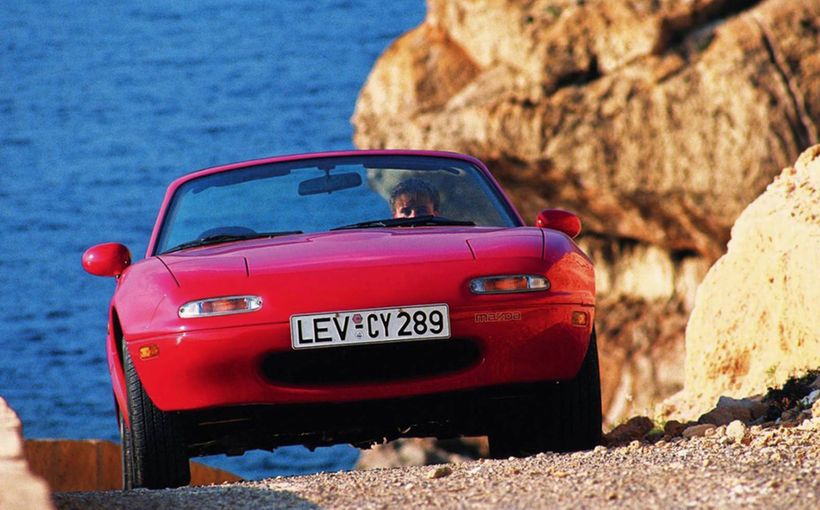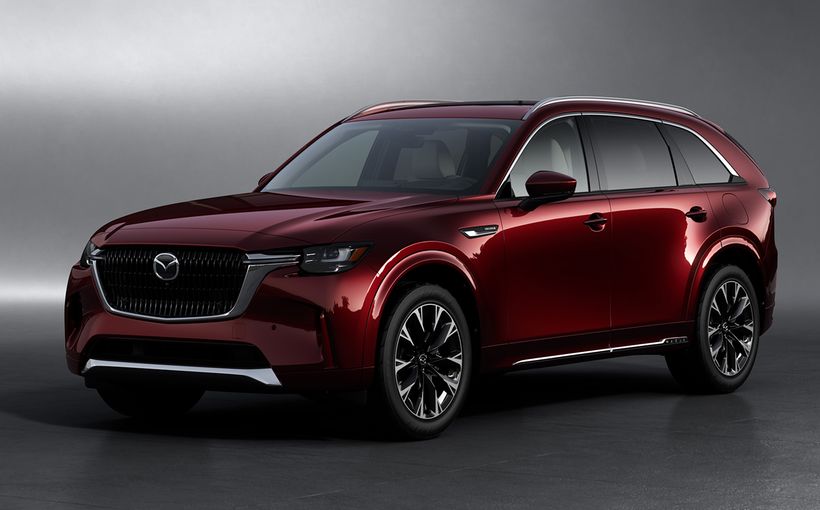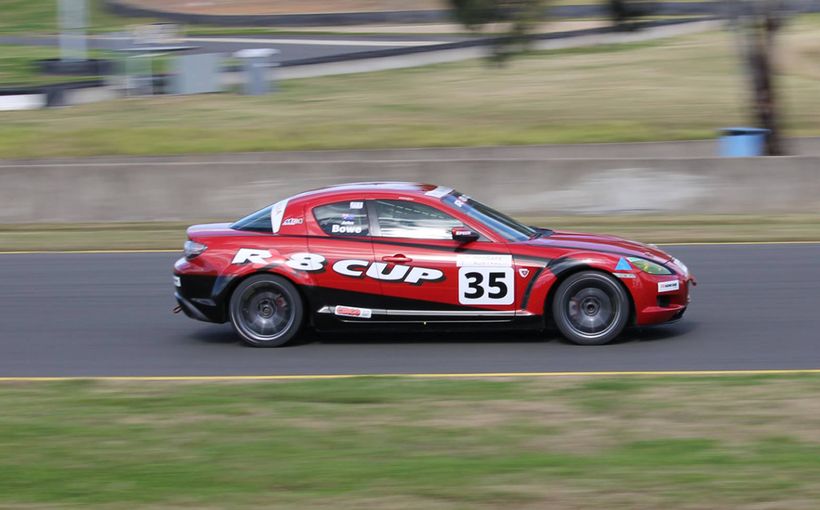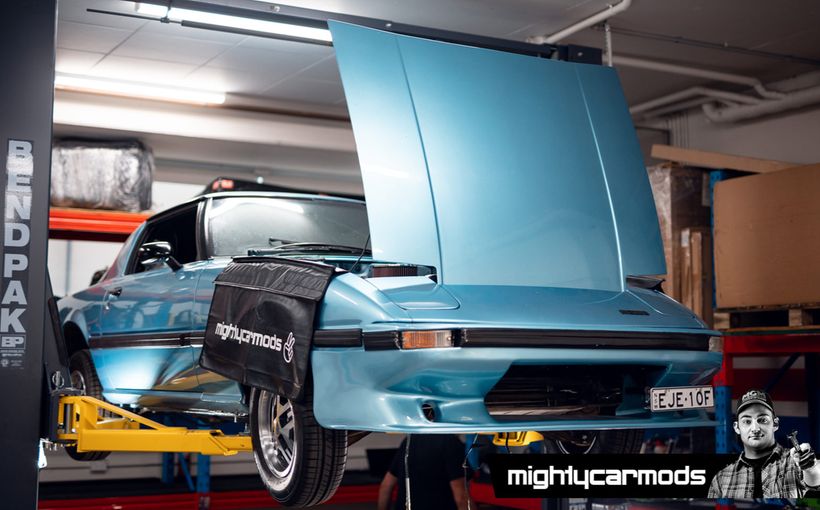Mazda RX Series: How Mazda strove for a rotary future

It was an up close and personal encounter with my mate’s newly acquired 1970 Mazda RX-2 coupe that caused me to revise my prejudices about Japanese cars. I have written of the on-road comparison between my Fiat 125 and the RX-2 elsewhere in the Shannons Club, but suffice it to say that the red Mazda proved itself to be in a far superior league to my yellow sedan.

Image: https://en.wheelsage.org/
Until that day, I had laboured under the misapprehension that European cars almost universally had superior dynamics to American, Australian and Japanese cars. Looking back with half a lifetime’s extra knowledge, I now realise how wrong I was. Having been spoiled by experiences with my father’s Peugeot 404 and a friend’s father’s Morris Cooper S at the straight-ahead of Japanese steering systems – I had rushed to judgement. It was 1976 and my own hands-on experience of Japanese cars had been limited to a brief ownership bout with a Mazda 1500 Special (the entry level variant) and short stints as a passenger in assorted models, of which the standout was a Datsun 1600, which in 1968 – along with the Fiat 125 – set a new performance benchmark for 1.6-litre sedans.
Arguably, the European manufacturers’ decades of experience refining conventional suspension systems had to count for something. And while the Fiat 125 – somewhat bewilderingly – had semi-elliptic springs on the rear, it probably had better all-round dynamics than the Mazda RX-2 in real world Australian conditions. With its coil springs located by four radius arms and a Panhard rod plus gas-filled rear dampers (a novel touch in 1970), the RX-2 had a much more sophisticated arrangement. But the ride was pitchy. The steering was per the standard Wheels Japanese car commentary of the time. However, around a racetrack, the Fiat driver would barely be aware of which lines the Mazda driver was taking as he sped away! The only advantage the Fiat enjoyed in circuit racing was its four-wheel disc braking system. Mazda rotaries persisted with drum brakes at the rear until the 1976 RX-5. As for the Fiat’s better steering feel, that counts for nought under racing conditions!

Image: https://en.wheelsage.org/
The RX-2 has been covered in depth in my Classic Car Garage story and my colleague Mark Oastler’s Racing Garage piece, as well as in an episode of Shannon’s Club TV. Suffice it to say here, that it was a truly radical newcomer to the Australian market because it brought the Wankel engine into the mainstream. This time it was the larger 12A version. It could run the standing quarter mile in less than 17 seconds and reach 115 miles per hour!

Where its R100 predecessor was a performance machine inhabiting the same sporty market sector as the Fiat 125 and Holden HK Monaro GTS 186S and, later, the Chrysler Valiant Pacer and Renault 16TS, the RX-2 was available in both coupe and sedan guises with optional three-speed automatic transmission and could viably claim to be an alternative to, say, an HK Premier as a family car. But its performance – approximately midway between a Torana GTR and the race-focused GTR XU-1 – was superior to any mainstream four-cylinder or six-cylinder family sedan.
Here was the first Mazda rotary to be offered as a true all-rounder; it proved that Toyo Kogyo was deadly serious about effecting a gradual transition to rotary-powered cars. Back in 1967, the company had given the motoring world notice of its intentions. Here is an extract from the brochure for the 110S:
Basically, your engine works on the same 300-year-old idea as the first steam engine. You know, with pistons that move up-down in a series of disparate starts and stops. Up. Stop. Down. Stop. It’s kind of like the old flicker movies: a little bit jerky and bumpy, no matter how fast you run it. Oddly enough, the point to this disjointed, vertical and straight-lined movement has been to move things smoothly, steadily and – circularly! The inconsistency of using these means to achieve those ends has been apparent for years. It’s as transparently incorrect as trying to fit square pegs into round holes.
So don’t get us wrong. We’re not the first to fault the old system. But we are the first to offer an alternative – a sound, solid, pragmatic, working alternative. One that works so well, in fact, that it runs circles around the old system.
If you are wondering what happened to NSU’s prior claims to introduce the Wankel rotary engine to production cars, the clue is in those four adjectives: sound, solid, pragmatic, working. (It is legendary now that back in the day NSU RO80 owners would pass each other with a number of fingers held out through the driver’s window to indicate how many replacement engines they had had – two, three, four…)
Reading this blurb, one cannot help but wonder how proud buyers of the new Mazda 1500 Luce must have felt; Toyo Kogyo was saying their proud new car was outmoded!
For Toyo Kogyo, it was essentially all going to plan until the first oil shock of the 1970s. Indeed, even General Motors had planned to introduce rotary-powered models and, famously, the 1975-76 Holden HJ/HX Premier was exported to Japan minus its six-cylinder engine to be re-powered and rebadged as the Mazda Roadpacer: even at the time this seemed like a serious curiosity!

Image: Mazda
With the release of the RX-3 in 1972, Mazda (Toyo Kogyo as it was then) confirmed its fascinating new policy. The first production rotary-engined Mazda, the 110S Cosmo was a limited edition sports coupe. The R100 was the first Mazda to offer the same body shell and running gear equipped with either a petrol or Wankel engine. But the RX-2 advanced the rotary cause with the availability of two- and four-door variants and the RX-3 exhibited the same policy with something of an advance because there was more to differentiate an RX-3 from a Mazda 808 with the rotary variants scoring a decorative longer nose. It was extended by four inches and incorporated unique frontal design.
In one’s mirrors the RX-3 looked much more assertive and menacing than the humble 808. Quad headlights flanked an eggcrate-style grille. Once it had overtaken you, there were round taillights in something of the idiom of early 1960s American Fords. Undoubtedly the extra 10cm were absolutely for show because the 10A – and later the 12A – Wankel engine took up far less space than the 808’s conventional powerplant.
Like the RX-2, the RX-3 interior was somewhat differentiated by a fake wood steering wheel. It also had a neat centre console, unlike the earlier model which essentially shared its dashboard with the Capella. In summary, the RX-3 is best understood as an uprated, restyled R100. Its heart was still the 10A rotary, which drove back through a slick-shifting all-synchro four-speed to a live rear axle suspended by leaf springs. In 1974, the RX-3 acquired the 12A engine and an even longer snout with a full-width grille.

Image: https://en.wheelsage.org/
The 1973 RX-4 followed the same formula. This was the Wankel version of the 929; both were available in sedan and coupe variants. Here was the first such Mazda to register more than 1000kg on the weighbridge, at around 1050; by contrast the RX-2 was 970 and the RX-3 about 880.
But while the RX-2 resembled an Alfetta or even a Datsun 180B, the RX-4 looked like no other car on the road. To many eyes it was fussy, especially in sedan guise with its kink in the body crease that ran the length of the car.

Image: https://en.wheelsage.org/
In 1974, the RX-4 was equipped with the new 13B engine, which endowed the biggest rotary Mazda yet seen with much superior torque. In this form, the RX-4 posted similar acceleration times to the 12A RX-2, but with much improved lowdown pulling power. The 13B also teamed much more happily with the optional automatic transmission.

Image: https//en.wheelsage.org/
Somewhat weirdly, the RX-4 did not inherit the RX-2’s coil rear suspension but reverted to semi-elliptics. But its wheels were an inch wider at 5.5 and handling was somewhat better, according to the road testers. However you look at those first three ‘RX’ models, none could be said to handle very well in unmodified form. Perhaps the Toyo Kogyo engineers were so focused on developing the Wankel engine and solving the worrisome seals issue that dynamics were never high among the priorities. Then again, no other mass-produced Japanese car of the early to mid-1970s distinguished itself in this domain.

Image: https://en.wheelsage.org/
Just when it looked as if Toyo Kogyo had established a lasting product plan, the arrival of the RX-5 showed a new direction. Aimed primarily at the US market, the RX-5 was available only as a coupe. It was if, the new Mazda was a smaller 1970s version of the 1958 Ford Thunderbird four-seater (‘Squarebird’). Essentially, it was new US-focused two-door body over updated RX-4 mechanicals. There was a five-speed manual transmission as standard and – finally – disc brakes on the rear wheels.
It weighed an astonishing 150kg more than an equivalent RX-4 and, in retrospect, may be seen as Toyo Kogyo’s first non-sports-focused rotary-engined product. Road & Track summed up the RX-5 succinctly:
However, for a car that was reputedly going to bring Mazda back into a strong position in US sales, the styling is undistinguished and the car may well go undetected except by other Mazda owners. The roll-down opera window is somewhat more a gimmick than anything else, the interior is garish, and the overall impression is dull.

Image: https://en.wheelsage.org/
Nothing like this could be said of the RX-5’s successor, the RX-7. It is difficult to be definitive about Toyo Kogyo’s product planning from 1965 to 1975 beyond the fact that the manufacturer had determined to make the aforementioned gradual transition to the position where rotary engines predominated. But sales were never brilliant and, for the most part, it seems that the Wankel-powered cars appealed to sports-minded buyers and few others. This perhaps was why after the moderately successful experiment that the RX-2, RX-3 and RX-4 could be said to have constituted, Toyo Kogyo’s visionaries turned back to the original 110S for inspiration.
The Mazda RX-7, which debuted on 30 March 1978, was arguably the most original new Japanese car of the 1970s (although both the Honda Civic and Accord could be challengers). Here was a true sports car masquerading as a coupe. Where all preceding Mazda rotaries except the 110S had been compromised by their essentially humdrum bodies designed for mass consumption, the RX-7 was a low-slung design that took advantage of the Wankel’s modest demands for space – compare its rakishly aero-looking front-end design with the RX-5’s blunt and upright look!

Image: https://en.wheelsage.org/
Joe Kenwright has written expertly about the RX-7 in Classic Garage, as has Mark Oastler in Racing Garage and, of course, there’s an episode of Shannons Club TV. The second-gen RX-7, benchmarked against the Porsche 944 and with champion racer Paul Frère as its development test driver, is also covered, along with its magnificent Twin Turbo successor.

Image: https://en.wheelsage.org/
But one car we have not looked until now is the RX-8.
To place the three RX-7 series and the RX-8 into the long-term historical framework of rotary-powered Mazdas is not easy. What does seem clear is that the switch in thinking that came with the original RX-7 – a switch to the dedicated sports car – was permanent. The most perplexing of these four cars is the RX-8, which in some respects represented a backward step.

Image: https://en.wheelsage.org/
The RX-8 secured the famous Wheels Car of the Year Award for 2003. I admit to being – and remaining – perplexed by this decision. It looks as if the judges were seduced by the cleverness of Mazda’s engineering of the four-door/four-seat configuration for a sports car:
The RX-8’s doors are key to its success. Mazda claims that with a fixed central body pillar, the RX-8’s wheelbase would have had to grow 150mm. The car does have what would normally be termed a B-pillar, but it’s hidden inside the forward edge of the rear door. When it’s shut, the concealed tubular steel member locks into the body structure top and bottom with high-strength latches…
…So the RX-8 really does a remarkably efficient and effective job of packaging genuine four-seat space into a tautly defined body.
Indeed, but so what? Who particularly wanted a four-door sports cars where the rear doors pretend (unsuccessfully) not to be visually apparent. This was an ingenious answer to a question no-one was asking outside Mazda headquarters.
The RX-8 offered brilliant dynamics along with this uniqueness of design, but it represented more than a little of an anti-climax after the magniloquent performance and sexy appearance of its twin-turbocharged predecessor. Sure, it could sprint to 100km/h in 6.4 seconds to nearly match the BMW M3 of a decade previously. But this performance figure fails to convey the dreadful shortfall of everyday useable torque from the naturally aspirated 13B engine. I lived with a manual RX-8 for a week and was not sorry to hand it back to Mazda Australia.
The problem was that, judged just by itself, the RX-8 deserved measured praise, but arriving as it did at the end of a long drive of memorable cars, it was a marked letdown.
In summary, the RX Mazdas have earned their Super Models guernsey. But the highlights along the way were surely the RX-2 coupe, the RX-3 coupe, the original RX-7 and the RX-7 Twin Turbo.









